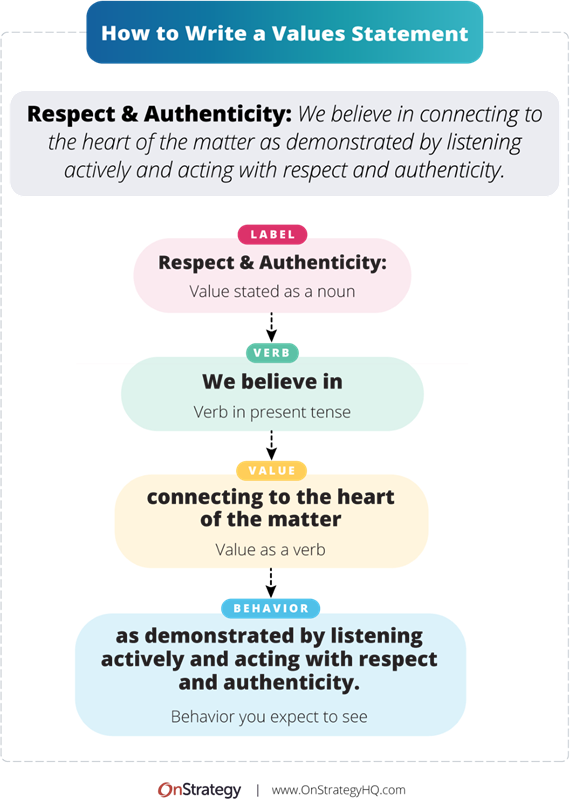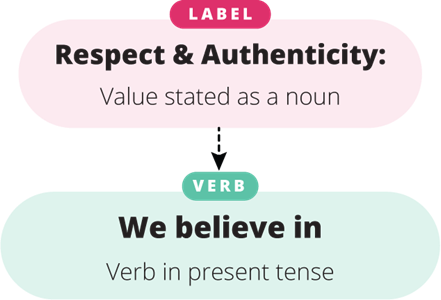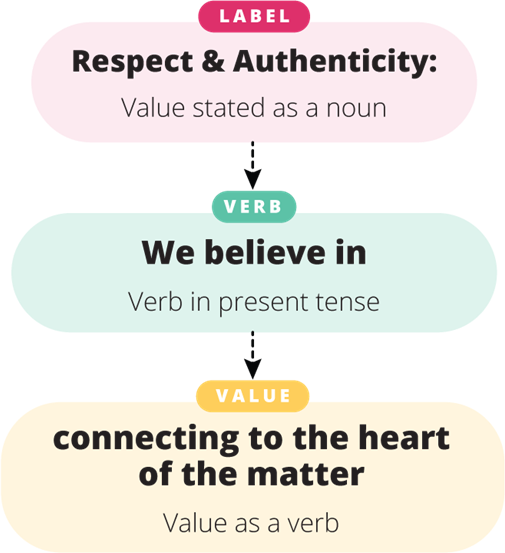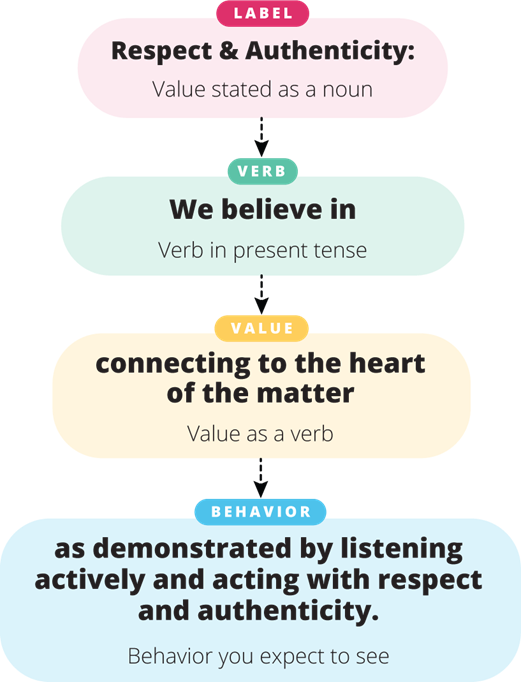Refresher on The Definition of Core Values
Your company’s core values must answer the question, “How will we behave?” In the context of your strategic planning process, core values help define and determine what is most important and non-negotiable to your organization.
Why are core values important?
Company core values are the articulation of the culture you want to permeate your team and the kind of behavior you hope and expect from each member. Check out the overview post on “what are core values” here! Save this article as the best way to structure your values.
Video Transcript – How to Write Core Values
Hi, I’m Erica Olsen with OnStrategy. Today’s whiteboard video is on core values. Your company’s core values answer the question, how will we behave? In a strategic planning process, you often hear, hey, we’re going to work on mission, vision values. So, we made this whiteboard video to help that piece of your strategic planning process.
But before we go too far, I just want to call out a critical point. Just because we say, mission and vision values doesn’t mean you need to define your core values as part of your strategic planning process. If you don’t have them, you’re starting from scratch. I recommend that you take values and put them into a dedicated process and work on that alone.
A great process we love is from Change the Culture, Change the Game. Check it out.
Let’s talk about what makes up a good core value, the components of it, how you know you did it right, and how you put it to use. So here is our anatomy of a core value. We love labels before the colon a value as a noun, in this case, respect and authenticity.
The most important part of core values is this piece: What behavior is expected? We are saying that this is how we expect everybody in the organization to behave, so that’s a great core value. We believe in connecting to the heart of the matter by listening respectfully and acting authentically.
Ideally, you would have five to seven core values, no less than three. Something people can remember. Yes, Zappos has like 12. That’s good for them, but we recommend less. When asking if you got it right, ask yourselves,” Are these core values our non-negotiables?” Meaning absolutely everybody should behave this way in your organization? You would stand by them no matter what happens, no matter what, no matter what, and as I said before, the behavior is clear.
So now that you have your core values or you’ve refreshed them, just a consideration: If you are refreshing them, consider putting them in a survey in the first phase of your planning process to get feedback on people’s perspectives on the new ways it looks when we’re behaving differently with this core value.
Great question. How do we use it? Publish it, of course, right? Maybe posters, on your intranet, or at the bottom of your SIG block, depending on where you want to see them. Importantly, could you reinforce it? I would like to reinforce it at the beginning of every staff meeting. Pick one or call out where you saw value in practice the week before.
Finally, from changing the culture, the game, and establishing intentional experiences that reinforce a core value. So, experiences in your organization reinforce respect and authenticity. So, with that, that’s a quick overview of the company’s core values.
You know how to get it right and construct strategies to make a difference in your organization. Don’t forget, as Peter Drucker said, culture eats strategy for lunch, and he’s right.
Why Do You Need Core Values in Strategic Planning?
First, this question depends on where you are in the strategic planning process regarding core values. If you are defining core values for the first time, we wouldn’t recommend discussing core values in your more extensive strategic planning process, along with your mission and vision.
Instead, we encourage you to create a dedicated process for your core values and work on them alone. Check out the book “Change the Culture, Change the Game” for ideas. Your organization’s culture depends on how well you define and live these core values, so they are worth space and time. We recommend including your stakeholder’s perspectives, but it can be hard to wordsmith your list of values together. Complete this exercise to identify your corporate values and have a dedicated writer create them instead.
However, if you’re re-evaluating and refreshing a set of core values that you already have, by all means, include these values in your strategic planning process. Your core values will help you stay focused on what’s most important as you align your company’s mission statement and vision with them. We don’t always recommend a core value change in every planning process; use your best judgment to assess if you need a refresh to impact your company culture and the entire workforce.
Pro-Tip: Personal values differ from company core values! Collective behaviors and culture influence core values for your business, whereas personal core values reflect an individual.
Get the Free Guide to Identify and Live Your Core Values
How to Write Nonprofit Core Values
If you’re a nonprofit, check out Prosper Strategies’ helpful post on four exercises to establish and actualize your nonprofit values. This is a helpful article for you to refer to as you work through writing your nonprofit values in the exercise below.
How to Write Core Values
As we jump into this 4-step exercise, check out this helpful breakdown on how to create core values for your organization. Also, don’t miss our post on 40 core values examples!

Step 1: Write core values expressed as a single noun.
We always like to start by writing the value as a simple, singular noun. It helps make your values clear and easy to spot.
Labels are beneficial for remembering and calling things out. So, could you start with a noun form of your core value? For example, one of our core values is “Respect and Authenticity.” Another is called “Forward Thinking.”

Here is a list of common values expressed as nouns. We do not advocate using these as your own but as fodder for inspiration.
How to create values expressed as nouns:
- Authenticity:
- Service:
- Communication:
- Innovation:
- Sustainability:
- Curiosity:
- Honesty:
- Transparency:
- Teamwork:
- Empathy:
Step 2: Writing a transition for the value to be expressed as a verb in the present tense.
Next, you want to start a statement about your commitment to the value using a verb in the present tense. Core values are constant and require action, so your statements should be in the present. Following the examples for “Respect and Authenticity” and “Forward-thinking,” our statements begin with “We believe in…” and “We challenge…”

Here’s how that might look in practice:
- Authenticity: We believe in
- Service: We strive to
- Communication: We are committed
- Innovation: We innovate together
- Sustainability: We believe in
- Curiosity: We approach
- Honesty: We always
- Transparency: We prioritize
- Teamwork: We work
- Empathy: We are
- Excellence: We are
Step 2: State the value in verb form.
Now, you want to state the value in verb form. For “Respect and Authenticity,” we have “connecting to the heart of the matter.” For “Forward Thinking,” we decided to ascribe the action “continually pursuing innovation.”

Here’s how that might look in practice:
- Authenticity: We believe in connecting to the heart of the matter
- Service: We strive to deliver the highest service standards in all we do
- Communication: We are committed to the timely and transparent exchange of information
- Innovation: We innovate together by using customer input
- Sustainability: We believe in action to boldly address the climate emergency
- Curiosity: We approach the world and each other with a sense of wonder
- Honesty: We always act in the light of the truth and do the right thing.
- Transparency: We prioritize transparency as a core principle of success
- Teamwork: We work in total alignment and support each other
- Empathy: We are empathetic, prioritize each other, and show kindness
- Excellence: We are a successful business by showing up
Step 3: State the behavior you expect to see as a result of the value.
You want it to be clear to each team member what behavior is expected. This step helps your core values statement be specific, clear, and unique.

Here are our complete examples from above—notice the specific behavior expected is outlined at the end of each value:
- Authenticity: We believe in connecting to the heart of the matter, as demonstrated by listening actively and acting with respect and authenticity.
- Service: We strive to deliver service standards in all we do and seek improvement from feedback from our partners and customers.
- Communication: We are committed to the timely and transparent exchange of information by encouraging respectful interactions through positive listening, positive intent, and understanding.
- Innovation: We innovate together by using customer input to drive our product development to serve our customer needs best.
- Sustainability: We believe in action to boldly address the climate emergency and commit to being a net-zero organization by 2026.
- Curiosity: We approach the world and each other with a sense of wonder by always asking each other questions, actively listening, and thinking critically.
- Honesty: We always act in the light of the truth and do the right thing by not withholding information, hiding setbacks, and providing the entire truth to our colleagues.
- Transparency: We prioritize transparency as a core principle of success by communicating clearly and providing all the information we need to be successful.
- Teamwork: We work in total alignment and support each other to make a positive impact.
- Empathy: We are empathetic, prioritize each other, and show kindness by listening intently, being sincere, and creating a safe work environment for each other.
- Excellence: We are a successful business by showing up and completing our best work every day.
Step 4: An assessment on how to write core values – did you get it right?
As you write core values statements, it’s helpful to run through this checklist to ensure each values statement aligns with the behaviors you expect to see from your organization. Here are a few helpful questions to consider to evaluate the quality of your core values statements:
- Is this value a non-negotiable? Is it critical to the culture and success of your organization?
- Are these your guiding principles, and how you expect your team to behave?
- Is the behavior you wish to see expressed in your values statement?
- Are you willing to stand by these values, even if it means losing an employee or customer?
It would also be a great idea to gather input from your organization. For example, especially in the initial phases of your strategic planning process, you might send out a survey with questions for each value, such as, “What does it look like when we are behaving with this core value?” and “How do we put this core value to use?” These can yield insightful ideas about your values and cement your team’s commitment to your core values.
Pro Tip:
We recommend a core values list of five to seven values. Keeping this list relatively short helps these values really stand out. Your core company values are principles you cannot or will not negotiate or compromise. They are unique to your organization, not something that sounds nice but could just as easily be copied and pasted into another organization.
3 Examples of Effective Core Values in Action
Every company has a different set of values and ways they deploy them in their organization. Here are three simple of examples of companies that are using values for the empowerment of their teams:
- Google’s core value of innovation can be seen in its continuous development of innovative products, pushing beyond the status quo.
- Patagonia’s emphasis on sustainability is showcased through its eco-friendly business practices, which align with its core values and make a positive impact on the environment.
- OnStrategy’s core principle of excellence is reflected in its dedication to providing top-notch consulting services. We always strive for the best work in every project we deliver.
Need help weaving core values and company culture together? Check out this helpful post for 11 tips for communicating your core values.
You also want to be intentional about creating experiences with your core values. Then, as you live your values consistently and intentionally, you will help to create a values-centered culture. And remember, the culture is what changes the game when it comes to organizational strategy.
Core Value FAQs
Check out our examples of core values list here!
The difference between company core values and personal values is for whom they serve. Obviously, personal values only serve an individual. Company values have a direct impact on a company culture and how you expect a group of people to behave, where personal value only guide the personal development of an individual.
Another key difference is that multiple people can influence core values and development in an organization. In any planning process, it is important to gather the common core values shared among your team and unite them to help create your company’s identify and behavior expectations.












